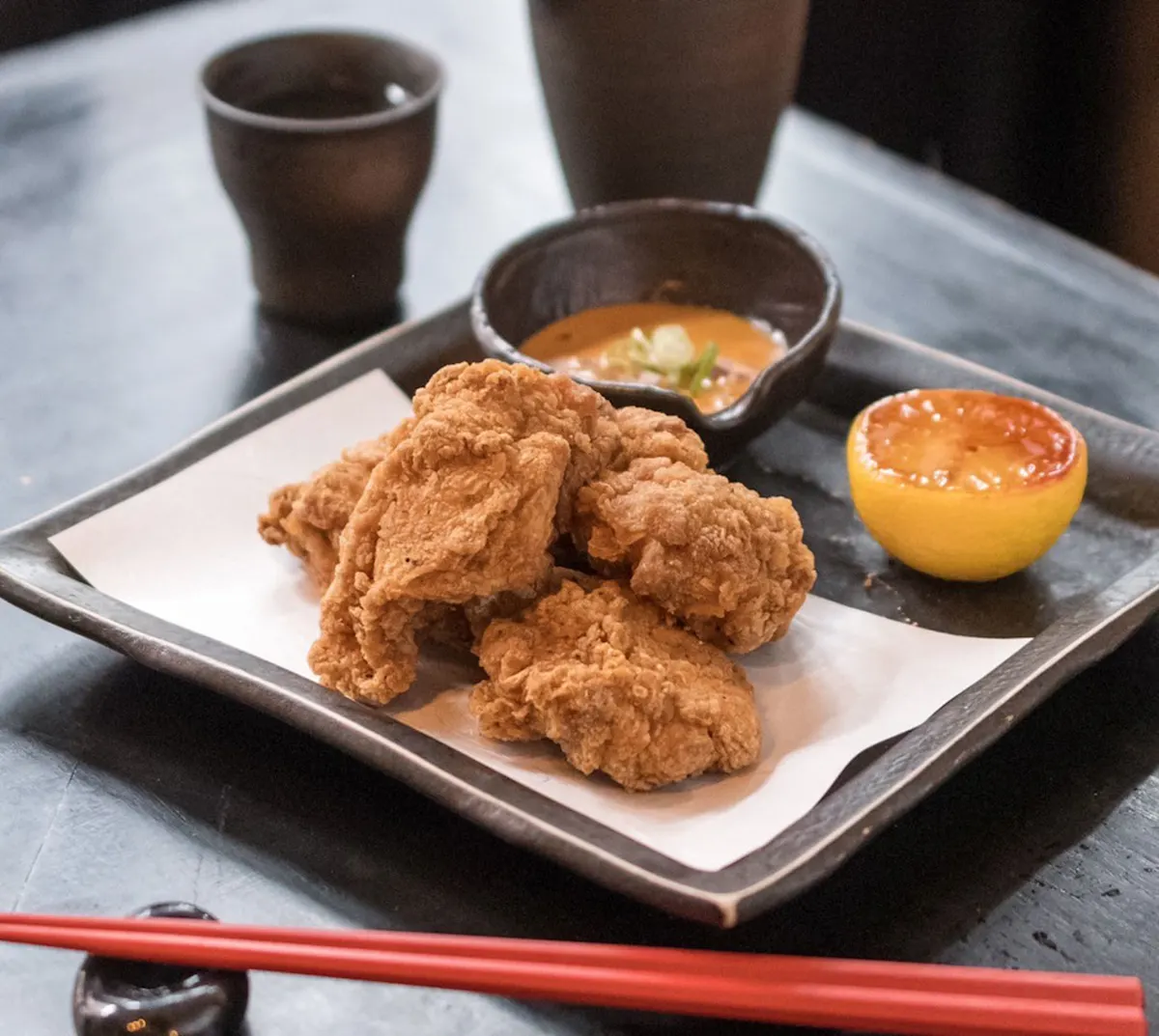Karaage is bar food at its best. The super-juicy, crunchy, flavorful fried chicken, ubiquitous in Japan’s izakayas, can now be found on menus throughout the U.S., taking its rightful place alongside Southern-style, buttermilk-dredged, Nashville hot, and Korean Dakgangjeong.
Karaage actually refers to a cooking technique invented more than a thousand years ago, often used to lightly fry tofu for vegetarian dishes, retaining the tofu’s soft, creamy interior while crisping up the outside. After World War II, when chicken was cheap, the Japanese started using this technique on poultry. These nuggets were so delicious that they took off, and now, karaage can be seen everywhere in Japan — in convenience stores like 7-Eleven, FamilyMart, and Lawson (apparently Anthony Bourdain’s favorite), in supermarkets and depachika (basement-level gourmet food stalls), and in izakayas, or Japanese bars, of course.
The most defining characteristic of karaage is a crispy exterior that contrasts the juicy tender meat within. This crunch is due to a dusting of potato starch, also known as katakuriko. Twice-fried, in high-smoke-point oils like rapeseed, canola, and peanut, sometimes with a bit of sesame oil blended in, the coated chicken is cooked first at a low temperature to cook the meat through, then at a high temperature, which delivers its signature crust.
“Bad fried chicken is one that doesn’t hold its crust; it slides off, like a slick naked bird,” says Ivan Orkin, of Ivan Ramen in New York City. Orkin follows the Japanese protocol of dredging his fried chicken in potato starch; after it’s fried, he breaks tradition by tossing it in a spicy, mildly tangy toasted garlic–caramel sauce. It’s flecked with togarashi (a Japanese chile spice blend) and served with a sidecar of shiso ranch for dipping.
A self-proclaimed “thigh guy,” Orkin equates karaage to Thanksgiving’s fowl: “People who don’t know how to make turkey think it’s horrible, but if you brine it, it’s much better.”
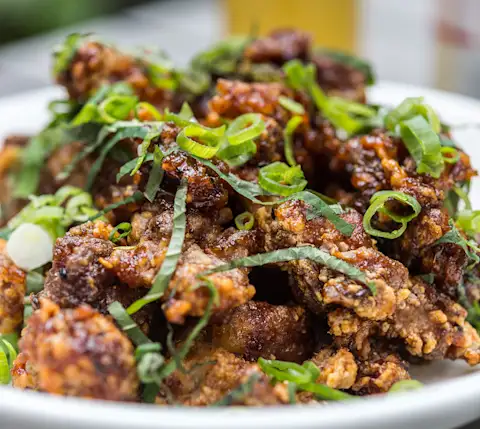
Indeed, karaage’s marinade is its secret sauce. At its baseline, it's an umami-rich bath of soy sauce, sake, and ginger, but can also include rice wine vinegar, sesame oil, mirin, mayonnaise, garlic, and spices.
Taking a different tack, Tokyo import Afuri in Portland and Beaverton, Oregon, works with boneless, skinlesschicken thighs instead of the usual skin-on, a decision they made when adapting to the American market, explains Zachary Ragghianti, one of Afuri’s culinary directors. “Karaage is a snacking fried chicken,” he says. Indeed, the restaurant group processes more than 1,000 chicken thighs a week. (That’s a lot of snacking!)
At their izakayas, the classic karaage set comes with yuzu kosho egg salad (a riff on a typical bento box side dish) and a lemon wedge. The Afuri Ramen + Dumplings shops serve more of a spicy Zangi-style, originating from Hokkaido, Japan. After the chicken is fried, it’s smothered in a sticky-sweet red chile sauce and served alongside a cup of cooling garlic mayo. You can sometimes find karaage perched atop their Kara Tsuyu Tsukemen, a cold bowl of curly, chewy ramen noodles, or as a single shining piece of spicy fried chicken pillowed between a soft steamed bao bun.
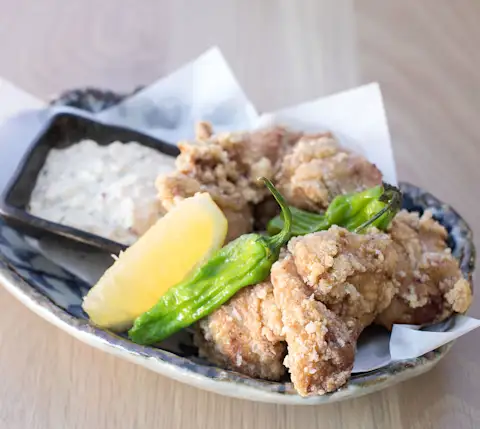
In the Bay Area, Japanese restaurant Pabu Izakaya opened in 2014, but karaage didn’t make it onto the menu until two years later, when founder Ken Tominaga and executive chef Kevin Schantz agreed that its popularity in Japan would translate to San Francisco. “It’s a comfort dish and is meant to be shared,” says Schantz, who suggests eating karaage using chopsticks — or your fingers. Pabu’s mixture of potato starch and cake flour keeps their chicken crunchy and fluffy, giving a darker, heavier fried chicken feel, similar to what you’d see in Oita, Japan, where wheat flour primarily coats karaage. Oita, aside from being home to the restaurant that claims to have first served karaage in its original form, also hosts an annual Karaage Festival that celebrates the modern range of the food’s canon.
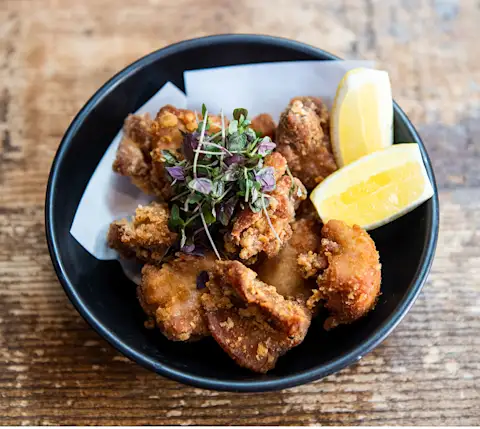
“I think karaage is really good for the ‘just one more thing’ order,” suggests Ken Chino, general manager of SakaMai, a modern sake bar on NYC’s Lower East Side. “It’s almost like an impulse buy at a supermarket.” At his restaurant, karaage handily outsells salads and desserts. “Our chef, Takanori Akiyama, has always been creative, a non-traditionalist, blending flavors of different cultures,” says Chino. Akiyama is from Miyazaki, the home of Chicken Nanban, a sweeter type of karaage that employs both mirin and sugar in the marinade. At SakaMai, Akiyama uses smoked paprika and harissa in his marinade, along with Saikyo miso, a sweeter version of shiro (white) miso — perhaps in homage to his hometown.
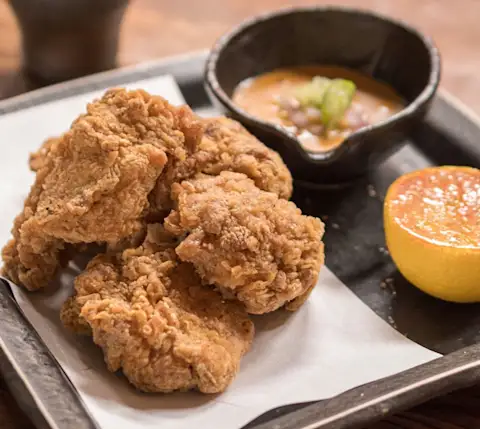
Since izakayas are known as drinking establishments, Chino suggests pairing karaage with a light beer, a classic Japanese whiskey highball, or a Chūhai (shochu highball with soda and lemon). But, honestly, even if you have nothing interesting to drink with it, you’re going to be happy ordering a big plate of karaage. It’s more than an appetizer — it’s a meal all on its own, and a perfect one at that.
Photo credit, from top to bottom: SakaMai (feature image), Hachikan Creative; Ivan Ramen, Daniel Krieger; Afuri; Pabu, Todd Porter and Diane Cu-Porter; SakaMai, Hachikan Creative.


